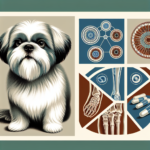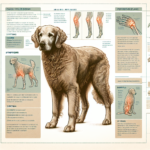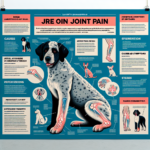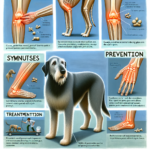Shih Tzu Joint Pain: Causes, Symptoms, Prevention, and Treatment

Introduction
The Shih Tzu, a toy breed known for its charming personality and luxurious coat, has a rich history dating back to ancient China. Originally bred as companion dogs for Chinese royalty, Shih Tzus are characterized by their affectionate nature, small size, and distinctive appearance, including a short muzzle and large, dark eyes. Despite their royal lineage, Shih Tzus are prone to several health issues, one of the most concerning being joint pain.
Joint health is crucial for Shih Tzus due to their small stature and genetic predispositions. Joint pain can significantly impact their quality of life, making it essential for owners to understand the causes, symptoms, prevention, and treatment options available for managing this condition.
Breed-Specific Joint Pain Risks
Genetic Predisposition
Shih Tzus are genetically predisposed to several joint-related issues, including hip dysplasia, arthritis, and elbow dysplasia. Hip dysplasia, a condition where the hip joint doesn’t fit properly into the hip socket, is particularly common. This misalignment can lead to arthritis and chronic pain over time. Elbow dysplasia, although less common, can also affect Shih Tzus, causing similar discomfort and mobility issues.
Age-Related Risks
As Shih Tzus age, the risk of developing joint pain increases. Typically, signs of joint issues may start to appear around middle age, which for Shih Tzus is around 5-7 years old. Senior Shih Tzus, those over 10 years old, are particularly vulnerable to arthritis and other degenerative joint conditions.
Activity Level and Joint Stress
While Shih Tzus are not as active as some other breeds, their playful nature and bursts of energy can still put stress on their joints. Activities such as jumping on and off furniture or running on hard surfaces can exacerbate joint issues. Additionally, Shih Tzus that are overweight or obese are at a higher risk of joint pain due to the extra stress on their joints.
Common Symptoms of Joint Pain in Shih Tzus
General Symptoms
- Limping or favoring one leg
- Stiffness, especially after resting
- Reluctance to jump, run, or climb stairs
- Decreased activity or playfulness
- Visible discomfort or pain when touched
- Swelling around the joints
Breed-Specific Symptoms
In Shih Tzus, joint pain may manifest more subtly due to their stoic nature. Owners might notice a decrease in their dog’s usual playful behavior or an increased preference for resting. Shih Tzus may also show signs of discomfort when being picked up or handled, particularly around the hip and elbow areas.
When to Consult a Vet
If your Shih Tzu exhibits any of the above symptoms for more than a few days, it’s crucial to consult a veterinarian. Early diagnosis and treatment can prevent further deterioration and improve your dog’s quality of life. Additionally, sudden or severe symptoms should prompt an immediate veterinary visit.
Preventive Measures for Joint Health
Exercise Recommendations
Regular, moderate exercise is essential for maintaining joint health in Shih Tzus. Short walks, gentle play sessions, and low-impact activities like swimming can help keep their joints flexible and muscles strong. Avoid high-impact activities such as jumping or running on hard surfaces, which can exacerbate joint stress.
Dietary Suggestions
A balanced diet rich in essential nutrients can support joint health. Foods containing glucosamine, chondroitin, and omega-3 fatty acids are particularly beneficial. These nutrients help maintain cartilage health and reduce inflammation. Consider incorporating high-quality commercial dog foods formulated for joint health or adding supplements as recommended by your veterinarian.
Weight Management
Maintaining a healthy weight is crucial for reducing joint stress in Shih Tzus. Obesity can significantly exacerbate joint pain and lead to other health issues. Monitor your dog’s weight regularly and adjust their diet and exercise routine as needed to keep them at an optimal weight.
Early Screening and Monitoring
Regular veterinary check-ups are essential for early detection of joint issues. Your vet may recommend specific screening tests, such as X-rays or joint fluid analysis, to identify problems before they become severe. Early intervention can significantly improve outcomes and slow the progression of joint diseases.
Treatment Options for Joint Pain
Non-Surgical Treatments
Non-surgical treatments for joint pain in Shih Tzus include medications, physical therapy, and lifestyle adjustments. Anti-inflammatory drugs and pain relievers can help manage symptoms, while physical therapy can improve mobility and strengthen muscles. Lifestyle changes, such as providing a comfortable bed and avoiding high-impact activities, can also alleviate joint stress.
Surgical Options
In severe cases, surgical intervention may be necessary. Common surgeries for joint pain include hip replacement, arthroscopy, and joint fusion. These procedures can provide significant relief and improve mobility, but they come with risks and require a thorough discussion with your veterinarian.
Alternative Therapies
Alternative treatments like acupuncture, hydrotherapy, and massage can also benefit Shih Tzus with joint pain. Acupuncture can reduce pain and inflammation, while hydrotherapy provides low-impact exercise that strengthens muscles without stressing the joints. Massage therapy can improve circulation and reduce muscle tension, providing additional relief.
Lifestyle and Management Tips
Daily Care Routine
A consistent daily care routine can help manage joint pain in Shih Tzus. This routine might include gentle exercise, a balanced diet, and regular administration of any prescribed medications or supplements. Monitoring your dog’s behavior and adjusting their routine as needed can also help manage symptoms effectively.
Modifying the Home Environment
Making your home more comfortable for a dog with joint pain can significantly improve their quality of life. Consider using ramps to help them access furniture or climb stairs, providing orthopedic beds for better support, and placing non-slip mats on slippery surfaces to prevent falls.
Long-Term Management
Long-term management of joint pain involves regular veterinary check-ups, ongoing monitoring of symptoms, and adjustments to your dog’s care routine as needed. Keeping your Shih Tzu active and engaged with low-impact activities can help maintain their mobility and overall well-being.
FAQs About Shih Tzus and Joint Pain
What are the early signs of joint pain in Shih Tzus?
Early signs of joint pain in Shih Tzus include limping, stiffness, reluctance to move, and decreased activity levels. If you notice any of these symptoms, consult your veterinarian for a thorough evaluation.
Can joint pain in Shih Tzus be prevented?
While genetic predispositions cannot be entirely prevented, maintaining a healthy weight, providing regular exercise, and ensuring a balanced diet can significantly reduce the risk of joint pain. Early screening and monitoring can also help catch issues before they become severe.
Are there specific foods that can help with joint health?
Yes, foods rich in glucosamine, chondroitin, and omega-3 fatty acids can support joint health. These nutrients help maintain cartilage and reduce inflammation. Consult your veterinarian for dietary recommendations tailored to your Shih Tzu’s needs.
When should I consider surgery for my Shih Tzu’s joint pain?
Surgery is typically considered when non-surgical treatments are no longer effective, and the dog’s quality of life is significantly impacted. Your veterinarian can help determine if surgery is the best option based on your dog’s specific condition and overall health.
Conclusion
Joint pain is a common issue in Shih Tzus, but with proper care and attention, it can be managed effectively. Understanding the causes, symptoms, prevention, and treatment options is crucial for maintaining your Shih Tzu’s joint health and overall well-being. Regular veterinary check-ups, a balanced diet, appropriate exercise, and a comfortable home environment can all contribute to a happier, healthier life for your beloved pet. By taking proactive measures and consulting your veterinarian regularly, you can help ensure your Shih Tzu enjoys a pain-free and active life.




